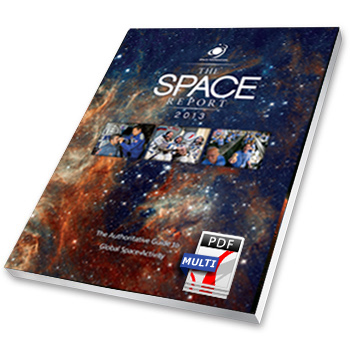Space Foundation News
Space Foundation's 2013 Report Reveals 6.7 Percent Growth in the Global Space Economy in 2012
Written by: developer
The global space economy grew to $304.31 billion in commercial revenue and government budgets in 2012, reflecting growth of 6.7 percent from the 2011 total of $285.33 billion. Commercial activity — space products and services and commercial infrastructure — drove much of this increase. From 2007 through 2012, the total has grown by 37 percent.
 Commercial space products and services revenue increased 6.5 percent since 2011, and commercial infrastructure and support industries increased by 11 percent.
Commercial space products and services revenue increased 6.5 percent since 2011, and commercial infrastructure and support industries increased by 11 percent.
Government spending increased by 1.3 percent in 2012, although changes varied significantly from country to country, with India, Russia and Brazil increasing budgets by more than 20 percent, while other nations, including several in Europe, experienced declines of 25 percent or more.
These new global space economic numbers come from the Space Foundation’s publication, The Space Report 2013: The Authoritative Guide to Global Space Activity, which was released today. Data was compiled from original research and a wide variety of public and private sources, and analyzed by Space Foundation researchers.
The Space Report Key Findings
The 160-page book contains worldwide space facts and figures and is illustrated with photographs, charts and graphs. Within are myriad examples of the benefits of space exploration and utilization, the challenges facing the space sector, the opportunities for future growth and the major factors that shape the industry. In addition, The Space Report includes an overview of each sector, easy-to-understand definitions and up-to-date information on space infrastructure, facilities, launches and programs.
Following are just some of the many interesting facts and analyses found in The Space Report 2013: The Authoritative Guide to Global Space Activity:
Launches
- 78 launch attempts took place in 2012, a drop of 7.1 percent from the 84 launches in 2011 (but higher than the 2010 total of 74).
- Russia led with 24 launches, China had 19 launches and the United States totaled 13 launches. For the second year running, the Chinese launch rate was greater than that of the United States.
- The United States led in terms of launch vehicle diversity, however, with ten types of orbital rockets launched in 2012.
Workforce
- According to U.S. Bureau of Labor Statistics (BLS) data, the size of the U.S. space workforce declined for the fifth year in a row, dropping 3.8 percent, from 252,315 in 2010 to 242,724 in 2011 (the most recent full year for which data is available) – a decrease of about 9,500 workers. However, the changes varied by sector, with some portions of the space industry growing while others contracted.
- The United States’ National Aeronautics and Space Administration (NASA)’s civil servant workforce decreased from 18,709 in fiscal year (FY) 2012 to 18,167 in FY 2013, a drop of 2.9 percent. However, there is evidence that the employment situation in areas with significant Space Shuttle-related layoffs, including Florida, is beginning to improve.
- Both Europe and Japan saw increases in space workforces; the European industry workforce showed very modest growth in 2011; in Japan, the overall workforce grew by 7.5 percent, while employment at the Japan Aerospace Exploration Agency (JAXA), Japan’s government space agency, dropped.
Space Products and Services
This year, The Space Report features an overview of how space agencies around the world move technology from space programs to commercial use. This includes a section about technology transfer mechanisms and patterns of innovation and technological development, including quantitative metrics. The Space Report also includes information about emerging technologies, giving a glimpse of some space-related technologies in early stages of development.
The Space Foundation Index
As of December 2012, the Space Foundation Index was 40.95 percent above its value at inception in June 2005. The Space Foundation Index and Space Foundation Services Index both outperformed the S&P 500 and the NASDAQ during 2012, while the Space Foundation Infrastructure Index did not perform as well as the NASDAQ, but slightly better than the S&P 500. These indexes, which are updated daily on the Space Foundation website, are easy-to-understand mechanisms for gauging the financial performance of space industry companies listed on U.S. stock exchanges.
 About the Book
About the Book
The Space Report is published annually by the Space Foundation, which works with a leading aerospace consulting firm, Futron Corporation, to research and analyze government and industry trends in space activity. The stock market analysis is provided by ISDR Consulting, LLC, a management consulting firm specializing in the space, satellite and technology sectors. The book is a “green” publication; the materials used in the processes for printing The Space Report 2013 have been certified as meeting the standards and requirements of the Forest Stewardship Council (FSC).
New for 2013
The Space Report 2013 includes a new infographic on the inside cover of the book showing the size of each part of the space economy. Readers will find it to be a handy reference guide for comparing different economic sectors.
The Space Report is on Sale Now
The Space Report is the definitive body of information about the global space industry. It is a valuable resource for government and business leaders, educators, financial analysts, students and space-related businesses.
The report can be purchased – in print or as a downloadable PDF – for $399. Purchases can be made online at www.TheSpaceReport.org or in the Space Foundation Store, located in the Lockheed Martin Exhibit Center Pavilion at the 29th National Space Symposium, to be held in Colorado Springs, Colo., April 8 -11.
This article is part of Space Watch: April 2013 (Volume: 12, Issue: 4).


